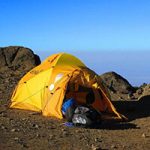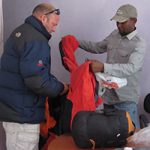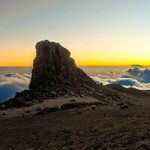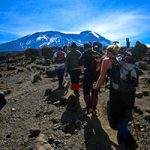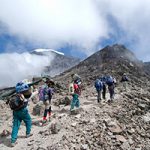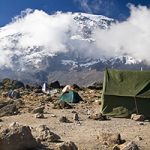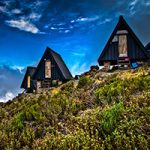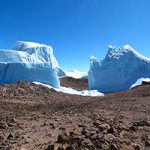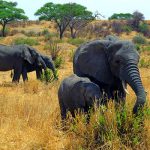What Is Altitude Sickness?
AMS – Acute Mountain Sickness
Important factors to consider when climbing or trekking are the effects that altitude may have on your body. All our guides are trained in first aid at altitude and all have experience in dealing with the different forms of altitude sickness. On all our expeditions we carry a pulse-oximeter which helps determine how your body is adapting to the higher altitude. We also carry bottled oxygen which can be used in emergencies.
One of the most important things to help lessen the effect of altitude on your body is to stay hydrated while ascending the mountain. We recommend you drink between 3 and 4 liters of water every day. If you do suffer from a severe form of altitude sickness the only real cure is descent to a lower level. If you are unlucky enough to suffer from a severe form of altitude sickness while on one of our expeditions you will be escorted to a lower level by a member of staff with medical training.
AMS, or acute mountain sickness (also known as altitude sickness), is what happens when the body fails to adapt in time to the lack of air pressure at altitude. There are three levels of AMS: mild altitude sickness, moderate altitude sickness and severe altitude sickness. On Kilimanjaro, it’s fair to say that most people will get some symptoms of the illness and will fall into the mild-to-moderate categories.
Given enough time, your body will adapt to the decrease in oxygen at a specific altitude. This process is known as acclimatization and generally takes one to three days at any given altitude. Several changes take place in the body which enable it to cope with decreased oxygen:
- The depth of respiration increase
- The body produces more red blood cells to carry oxygen
- Pressure in pulmonary capillaries is increased, ‘forcing’ blood into parts of the lung which are not normally used when breathing at sea level
- The body produces more of a particular enzyme that causes the release of oxygen from hemoglobin to the body tissues
It is not the height that is most troublesome, but the rate of ascension. It is difficult to determine who may be affected by altitude sickness since there are no specific factors such as age, sex, or physical condition that correlate with susceptibility.
At over 10.000 feet (3.000m), more than 75% of climbers will experience at least some form of mild AMS.
There are four factors related to AMS:
High Altitude
Fast Rate of Ascent
High Degree of Exertion
Dehydration
The 3 Levels of Acute Mountain Sickness (AMS)
1. Mild AMS
Having symptoms of mild AMS is not necessarily a sign that the sufferer should give up climbing Kili and descend immediately. Indeed, most or all of the symptoms suffered by those with mild AMS will disappear if the person rests and ascends no further, and assuming the recovery is complete, the assault on the summit can continue.
The symptoms of Mild AMS include:
- Headache
- Nausea & Dizziness
- Loss of appetite
- Fatigue
- Shortness of breath
- Disturbed sleep
- General feeling of malaise
2. Moderate AMS
The same goes for moderate AMS too, though here the poor individual and his or her symptoms should be monitored far more closely to ensure that they are not getting any worse and developing into severe AMS.
The signs and symptoms of Moderate AMS include:
- Severe headache that is not relieved by medication
- Nausea and vomiting, increasing weakness and fatigue
- Shortness of breath
- Decreased coordination (ataxia)
3. Severe AMS
This is a lot more serious and sufferers with severe AMS should always descend immediately, even if it means going down by torchlight in the middle of the night.
Severe AMS results in an increase in the severity of the aforementioned symptoms including:
- Shortness of breath at rest
- Inability to walk
- Decreasing mental status
- Fluid build-up in the lungs
HAPE & HACE
Severe AMS requires immediate descent of around 2.000 feet (600m) to a lower altitude. There are two serious conditions associated with severe altitude sickness; High Altitude Cerebral Edema (HACE) and High Altitude Pulmonary Edema (HAPE). Both of these happen less frequently, especially to those who are properly acclimatized. But, when they do occur, it is usually in people going too high too fast or going very high and staying there. In both cases the lack of oxygen results in leakage of fluid through the capillary walls into either the lungs or the brain.
High Altitude Pulmonary Edema (HAPE)
HAPE results from fluid build-up in the lungs. This fluid prevents effective oxygen exchange. As the condition becomes more severe, the level of oxygen in the bloodstream decreases, which leads to cyanosis, impaired cerebral function, and death.
Symptoms of HAPE:
- Shortness of breath at rest
- Tightness in the chest
- Persistent cough bringing up white, watery, or frothy fluid
- Marked fatigue and weakness
- A feeling of impending suffocation at night
- Confusion, and irrational behaviour
Action to take:
Confusion, and irrational behaviour are signs that insufficient oxygen is reaching the brain. In cases of HAPE, immediate descent of around 2.000 feet (600m) is a necessary life-saving measure. Anyone suffering from HAPE must be evacuated to a medical facility for proper follow-up treatment.
High Altitude Cerebral Edema (HACE)
HACE is the result of the swelling of brain tissue from fluid leakage.
Symptoms of HACE:
- Headache
- Weakness
- Disorientation
- Loss of co-ordination
- Decreasing levels of consciousness
- Loss of memory
- Hallucinations & Psychotic behavior
- Coma
Action to take:
This condition is rapidly fatal unless the afflicted person experiences immediate descent. Anyone suffering from HACE must be evacuated to a medical facility for follow-up treatment.
You are in Safe Hands with KCC
Our guides are all experienced in identifying altitude sickness and dealing with the problems in order for you to continue your climb. Of course, there is always the chance that you will have to abandon your climb. In these situations, the guide will tell you to descend. It is not a request, but an order. Do not try to convince him with words, threats or money to continue your climb. The guide wants you to succeed on your climb, but will not jeopardize your health. Respect the decision of the guide.




